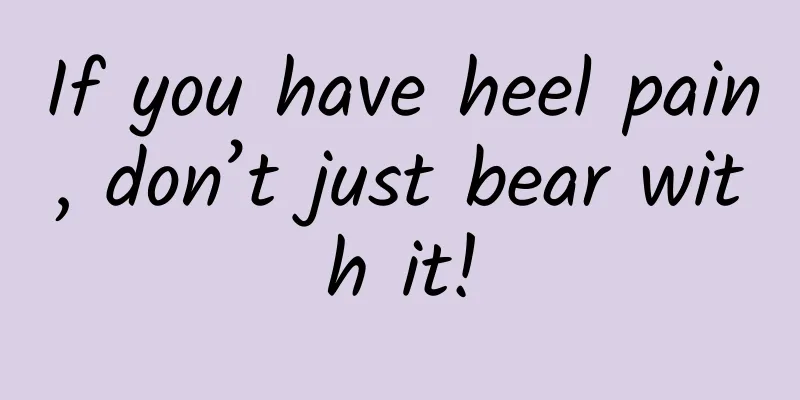If you have heel pain, don’t just bear with it!

|
Author: Tang Qin, Deputy Secretary-General of the Science Popularization Expert Committee of the Chinese Medical Association, Researcher Reviewer: Zhang Jianzhong, Director of the Foot and Ankle Surgery Center of Beijing Tongren Hospital, Professor Long-term walking and excessive weight-bearing will put a burden on the heel (commonly known as the "heel"), and may even cause local aseptic inflammation, leading to heel pain, also known as heel pain. The fat pad in the heel of the elderly has begun to shrink, and the arch of the foot has collapsed to a certain extent, which significantly weakens the elderly's ability to buffer the impact of the ground, making them more likely to experience heel pain. Figure 1 Copyright image, no permission to reprint 1. What is heel pain? Heel pain is a common foot and ankle problem, which refers to pain on one or both sides of the heel, but without redness or swelling. Patients often have difficulty walking due to the pain. Most heel pain is caused by lesions in the heel bones, joints, bursae, fascia, etc. It is mainly divided into plantar fasciitis and Achilles tendinitis. 1. Plantar fasciitis Plantar fasciitis is very common and often occurs in people who stand or walk for long periods of time. It can also be caused by long-term or chronic minor injuries. Its pain is located under the heel - the place where the heel lands, that is, the bottom of the heel. Plantar fasciitis is associated with overactivity, irregular activity, sudden physical activity, wearing inappropriate shoes, and more intense physical activity without stretching or warming up beforehand. 2. Achilles tendinitis Achilles tendinitis also causes pain in the back of the heel, but the pain is located behind the heel rather than at the point of contact. There are internal and external causes of Achilles tendinitis. The internal cause is mainly the hyperplasia of the posterior superior tubercle of the ankle bone; the external cause is mainly a sudden increase in exercise, such as long-distance walking. Achilles tendonitis is also known as "entry-type Achilles tendonitis" in medicine. It is related to Achilles tendon degeneration, excessive exercise, heavy weight, smoking, use of quinolones, and some systemic diseases (such as gouty arthritis, ankylosing spondylitis, etc.). Figure 2 Copyright image, no permission to reprint 2. Examination of heel pain Heel pain is manifested as pain on the front and inner side of the heel sole, which is obvious when starting and can be alleviated or even completely relieved after exercise. The causes of the disease are often related to lack of activity, irregular exercise and obesity. The examination usually includes checking whether the blood uric acid is abnormal and whether the HLA-B27 gene is positive to rule out ankylosing spondylitis. In addition, it is necessary to take X-rays of the feet to see if there is bone hyperplasia or fatigue fracture in the heel. Some people may need magnetic resonance imaging (MRI) to see whether the Achilles tendon and plantar fascia are deformed or ruptured and whether the heel bone is swollen. Treatment of heel pain 1. Plantar fasciitis can be treated through rehabilitation training, shock wave therapy, foot pad support and night splints. The best treatment is stretching training and wearing supportive shoes; in addition, you can take some analgesics as prescribed by your doctor. Most patients can get good results, and only a few patients may need surgical treatment. 2. Patients with Achilles tendinitis can take oral or topical analgesics, do stretching exercises to treat, and relieve through physical therapy, rest, and weight loss. If the inflammation persists and causes local Achilles tendon calcification, surgical treatment is required. 3. Shock wave therapy is a very effective minimally invasive treatment method. Foot pads can also be used to reduce the stress on the plantar fascia and promote recovery of injuries. 4. Conservative treatment is recommended for patients with first attack or mild symptoms, such as rest, local hot compress, wearing loose shoes with heels and laces, avoiding strenuous activities, and local application of anti-inflammatory and analgesic ointments. If conditions permit, shoes without rear uppers can be worn to relieve local pressure. 5. If symptoms recur and cannot be relieved by conservative treatments, or if the pain symptoms are severe, surgical treatment is generally recommended. 6. For extremely severe pain, blockade can also be considered, which has a good analgesic effect, but the recurrence rate is also high. In addition, multiple injections are not recommended, because the adverse reactions of the hormones contained in the blockade may cause rupture of the plantar fascia. 7. Wear shoes with a little heel and soft lining to avoid frequent stimulation. At the same time, pay more attention to rest and avoid excessive strenuous activities. Figure 3 Copyright image, no permission to reprint 4. Self-exercise for heel pain Long-term incorrect walking posture leads to improper force, which can cause heel pain and discomfort. In daily life, we can exercise ourselves through the following methods. 1. Stretch your calves and Achilles tendons frequently : Massage and stretch the soles of your feet frequently, avoid walking on uneven surfaces for long periods of time, avoid repeated rolling movements with your heels, and keep your weight within an appropriate range. 2. Loosen the plantar fascia : Use your feet to step on the ball and massage and relax it back and forth. The ball can be about the size of a tennis ball. 3. Plantar fascia stretching : The patient sits and grabs the toes with his hands and pulls them upward and backward until the patient feels the sole of the foot being pulled apart. Generally, hold for about 20 seconds and then relax. Do 3 to 5 times as a set, and 3 sets a day. 4. Gastrocnemius stretch : The patient stands facing the wall, with both hands on the wall and keep them level with the shoulders, then stretch the affected leg as far back as possible, with the heel as close to the ground as possible. The body is tilted forward, and the knee of the front leg is slightly bent. Generally, it is maintained for 20 to 30 seconds. 3 times per set, 3 to 5 sets per day. 5. Strengthen the plantar fascia and muscle strength : Grab a towel with your toes. Spread a towel flat on the ground, and the patient places his feet flat on the towel, then puts his heels on the ground, while constantly grabbing the towel with his toes and then letting it go. Do this 10 to 20 times per set, and repeat 3 sets. In addition to self-exercise, you can also apply ice to your heels for 10 minutes every day to relieve symptoms. In addition, pay attention to the shoes you wear. It is best to choose shoes with a supportive arch structure, thick heels that are flexible and have a shock-absorbing effect. Do not wear high heels or extremely flat shoes. The heel height should be around 1 inch (3.3 cm). There should be enough space in front of the shoe to accommodate the toes: when the toes are pushed against the front of the shoe, the heel can still accommodate a finger. Foot disease is an unspeakable pain for the elderly, but they rarely seek medical attention for heel pain. It is important to seek medical attention as soon as possible before the foot disease reaches the stage where surgery is required, and not to avoid seeking medical attention. |
<<: How did the most silent organ in the body turn into a killer?
Recommend
From point A to point B, the ant walks in a straight line? It's actually Brownian motion
Produced by: Science Popularization China Author:...
How to write good information flow copywriting ideas? 5 creative ideas to help you get inspiration quickly!
Due to the particularity of information flow adve...
Guizhou’s journey is to the top of thousands of mountains!
This may be the fastest changing province in Chin...
An egg falling from a high altitude can kill a person, so why can a cat jump from the 32nd floor and survive?
Editor’s Note: Please do not conduct any tests or...
Status bar prompts with various effects
Source code introduction The demo can provide a v...
Subaru, known as the next Suzuki, released its first pure electric car, which will be launched next year
Japanese automobile brand Subaru today unveiled t...
How to promote enrollment in training institutions and educational training schools?
In recent years, the education and training indus...
Event Operation: To clarify “brand exposure event”, start by understanding these 5 points!
"Brand exposure activities" are activit...
After viewing more than 100,000 information flow ads, I summarized these 4 optimization directions!
After reading this article, you will get the foll...
Today is the beginning of autumn丨After the rain, the locust flowers bloom and the willow shadows are about to fall
August 7, 20:29 Beijing time We will usher in the...
#千万IP创科普# Four Seasons Pharmacist says丨Avoid the sun after taking medicine? Know about photosensitivity reactions in advance!
With the arrival of summer, in addition to the in...
From the streets to the Olympics, skateboarding should be seen!
Review expert: Peng Guoqiu, deputy chief physicia...
Is it useful to develop a tourist visa mini program? What is the best way to do it?
The domestic economy has developed very rapidly i...
Highly cute alert! We are serious about rescuing wild animals!
The Oriental White Stork is an endangered species...
Short video planning and operation guide!
During last year's National Day, Zhang Ce and...









